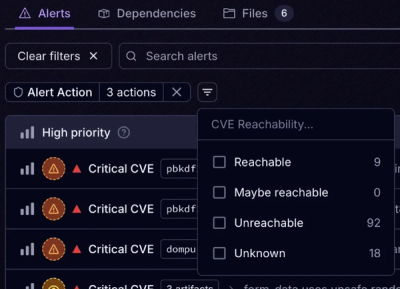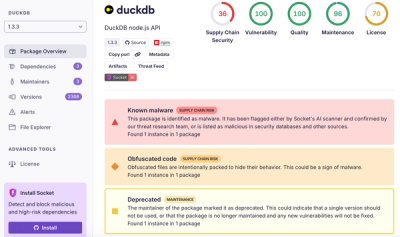
Product
Introducing Tier 1 Reachability: Precision CVE Triage for Enterprise Teams
Socket’s new Tier 1 Reachability filters out up to 80% of irrelevant CVEs, so security teams can focus on the vulnerabilities that matter.
grunt-firefox-manifest
Advanced tools
Create a Firefox manifest from your projects package.json.
This plugin requires Grunt ~0.4.1
If you haven't used Grunt before, be sure to check out the Getting Started guide, as it explains how to create a Gruntfile as well as install and use Grunt plugins. Once you're familiar with that process, you may install this plugin with this command:
npm install grunt-firefox-manifest --save-dev
Once the plugin has been installed, it may be enabled inside your Gruntfile with this line of JavaScript:
grunt.loadNpmTasks('grunt-firefox-manifest');
In your project's Gruntfile, add a section named firefoxManifest to the data object passed into grunt.initConfig().
grunt.initConfig({
firefoxManifest: {
options: {
// Task-specific options go here.
},
your_target: {
// Target-specific file lists and/or options go here.
},
},
});
Type: String
Default value: 'package.json '
The location of the package.json to use as the data source.
Type: String
Default value: 'manifest.webapp'
The location where to write the Firefox manifest to.
Using the default options generates a manifest.webapp file next to your package.json.
grunt.initConfig({
firefoxManifest: {
options: {}
},
});
If one of the files is located in a different location, pass the path to it as a param:
grunt.initConfig({
firefoxManifest: {
options: {
packageJson: 'app/package.json',
manifest: ' dist/manifest.webapp',
}
},
});
Add a section firefoxManifest to your package.json where you provide the needed information for the manifest. If you don't provide name, description, version or developer in the firefoxManifest section, then the fields of the package.json will be used instead (developer falls back to author).
Assume we have a package.json like the following:
{
"name": "My App",
"description": "My App description",
"version": "0.4.0",
"author": {
"name": "The developer",
"email": "email@example.com",
"url": "http://example.com/"
},
"engines": {
"node": ">= 0.8.0"
},
"scripts": {
"test": "grunt test"
},
"firefoxManifest": {
"permissions": {
"geolocation": {
"description": "Required to locate you."
}
},
"icons": {
"128": "/img/icon-128.png"
},
"appcache_path": "/manifest.appcache",
"launch_path": "/"
}
}
This will generate the following manifest.webapp:
{
"name": "My App",
"description": "My App description",
"version": "0.4.0",
"permissions": {
"geolocation": {
"description": "Required to locate you."
}
},
"icons": {
"128": "/img/icon-128.png"
},
"appcache_path": "/manifest.appcache",
"launch_path": "/",
"developer": {
"name": "The developer",
"email": "email@example.com",
"url": "http://example.com/"
}
}
In lieu of a formal styleguide, take care to maintain the existing coding style. Add unit tests for any new or changed functionality. Lint and test your code using Grunt.
FAQs
Create a Firefox manifest from your projects package.json.
We found that grunt-firefox-manifest demonstrated a not healthy version release cadence and project activity because the last version was released a year ago. It has 1 open source maintainer collaborating on the project.
Did you know?

Socket for GitHub automatically highlights issues in each pull request and monitors the health of all your open source dependencies. Discover the contents of your packages and block harmful activity before you install or update your dependencies.

Product
Socket’s new Tier 1 Reachability filters out up to 80% of irrelevant CVEs, so security teams can focus on the vulnerabilities that matter.

Research
/Security News
Ongoing npm supply chain attack spreads to DuckDB: multiple packages compromised with the same wallet-drainer malware.

Security News
The MCP Steering Committee has launched the official MCP Registry in preview, a central hub for discovering and publishing MCP servers.